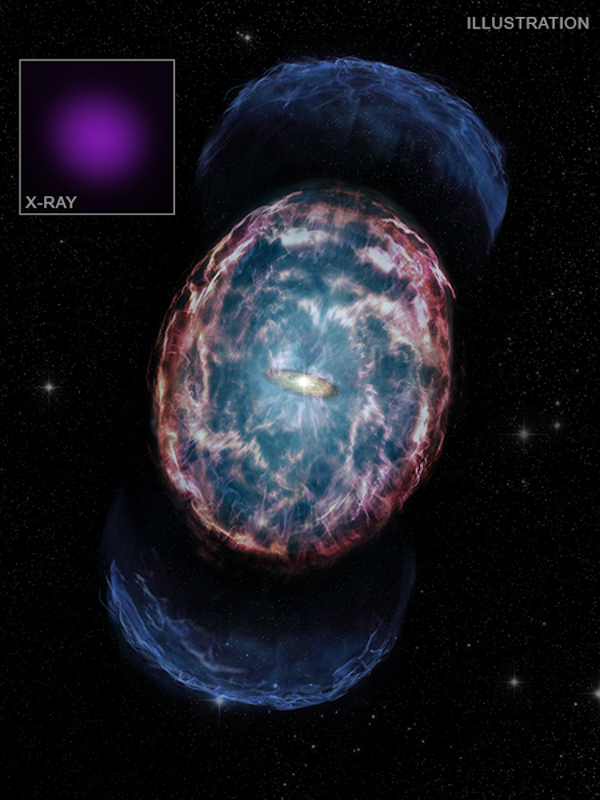
 Credit: X-ray: NASA/CXC/Northwestern Univ./A. Hajela et al.; Illustration: NASA/CXC/M.Weiss
Credit: X-ray: NASA/CXC/Northwestern Univ./A. Hajela et al.; Illustration: NASA/CXC/M.Weiss
Still Basking in the Golden Afterglow
A gravitational wave event on August 17, 2017 detected nearly simultaneously with a Gamma-ray burst showed, for the very first time, the merger of two tiny neutron stars, generating multi-messenger radiation due to the acceleration of massive particles (predicted by Einstein) and the acceleration of electrically-charged particles (predicted by Maxwell). This event was a golden opportunity to see what happens when incredibly dense objects like neutron stars collide. The story of how followup observations by the One-Meter, Two-Hemisphere team found an optical transient in a unobtrusive galaxy known as NGC 4993 is now a classic story of astronomical discovery. Pinpointing the site of the neutron star merger allowed followup observations throughout the electromagnetic spectrum, including important X-ray studies using the Chandra X-ray Observatory and other facilities. These followup observations have given astrophysicists a detailed picture of what occurs when two neutron stars slam into each other. The illustration above shows one model of the ejected remnants of the explosion, with an inner accretion disk surrounding a possible newborn black hole at the site of the merger. In the intervening years, this event has been the only one detected in both gravitational and electromagnetic radiation. So what's happened since? Although the source's gravitational radiation has long since faded, and the source is undetectable in most electromagnetic bands, the hot X-ray emission from the afterglow of the explosion can still be seen, but only the Chandra X-ray Observatory is powerful enough to still see it. The inset image above shows a recent image of the X-ray afterglow from Chandra. The X-ray data suggest that the shock produced by the merger has broken out and is now slamming into the galactic gas and dust surrounding the former binary system. The outer glowing arcs illustrate the charged particle jet believed to have initially formed when the two neutron stars merged.
Published: April 4, 2022
<
HEA Dictionary ● Archive
● Search HEAPOW
● Other Languages
● HEAPOW on Facebook
● Download all Images
● Education ● HEAD
>

Each week the HEASARC
brings you new, exciting and beautiful images from X-ray and Gamma ray
astronomy. Check back each week and be sure to check out the HEAPOW archive!
Page Author: Dr. Michael F. Corcoran
Last modified Tuesday, 27-Feb-2024 10:15:18 EST


